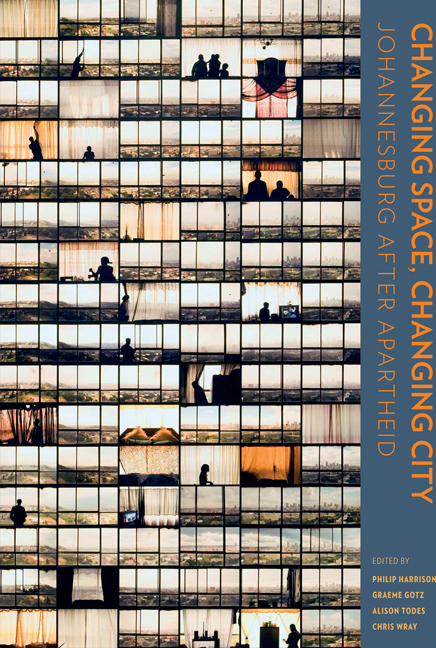Book contents
- Frontmatter
- Contents
- Preface
- Cartography
- 1 Materialities, subjectivities and spatial transformation in Johannesburg
- Section A The macro trends
- Section B Area-based transformations
- 12 Between fixity and flux: Grappling with transience and permanence in the inner city
- 13 Are Johannesburg's peri-central neighbourhoods irremediably ‘fluid’? Local leadership and community building in Yeoville and Bertrams
- 14 The wrong side of the mining belt? Spatial transformations and identities in Johannesburg's southern suburbs
- 15 Soweto: A study in socio-spatial differentiation
- 16 Kliptown: Resilience and despair in the face of a hundred years of planning
- 17 Alexandra
- 18 Sandton Central, 1969–2013: From open veld to new CBD?
- 19 In the forest of transformation: Johannesburg's northern suburbs
- 20 The north-western edge
- 21 The 2010 World Cup and its legacy in the Ellis Park Precinct: Perceptions of local residents
- 22 Transformation through transportation: Some early impacts of Bus Rapid Transit in Orlando, Soweto
- Section C Spatial identities
- Contributors
- Photographic credits
- Acronyms
- List of plates
- List of figures
- List of tables
- Index
16 - Kliptown: Resilience and despair in the face of a hundred years of planning
from Section B - Area-based transformations
Published online by Cambridge University Press: 20 April 2018
- Frontmatter
- Contents
- Preface
- Cartography
- 1 Materialities, subjectivities and spatial transformation in Johannesburg
- Section A The macro trends
- Section B Area-based transformations
- 12 Between fixity and flux: Grappling with transience and permanence in the inner city
- 13 Are Johannesburg's peri-central neighbourhoods irremediably ‘fluid’? Local leadership and community building in Yeoville and Bertrams
- 14 The wrong side of the mining belt? Spatial transformations and identities in Johannesburg's southern suburbs
- 15 Soweto: A study in socio-spatial differentiation
- 16 Kliptown: Resilience and despair in the face of a hundred years of planning
- 17 Alexandra
- 18 Sandton Central, 1969–2013: From open veld to new CBD?
- 19 In the forest of transformation: Johannesburg's northern suburbs
- 20 The north-western edge
- 21 The 2010 World Cup and its legacy in the Ellis Park Precinct: Perceptions of local residents
- 22 Transformation through transportation: Some early impacts of Bus Rapid Transit in Orlando, Soweto
- Section C Spatial identities
- Contributors
- Photographic credits
- Acronyms
- List of plates
- List of figures
- List of tables
- Index
Summary
Kliptown, located 25 km south-west of the Johannesburg city centre and today part of the township of Soweto, is best known in South African history as the site where the Freedom Charter was signed at the 1955 Congress of the People. The Freedom Charter became a seminal document of the liberation movement, outlining in ten clauses a vision for a future socialist democracy. When the apartheid regime collapsed in the 1990s, it seemed obvious that the site where this event had taken place should be officially commemorated along with many other sites, stories and public memories connected to the anti-apartheid struggle. But Kliptown is also a unique settlement with a multilayered spatial, political and social history. The act of commemoration and its accompanying development agenda is one of several imprints of a planning framework on Kliptown. Each planning intervention has been stymied by the disjuncture between the interventions of the state and the perceptions and needs of the local community. In this chapter we look at some of those complexities, tracing a century of state spatial interventions in Kliptown. We draw on archival research into the history and development of Kliptown, in-depth interviews conducted for research into the area's history and local responses to planning efforts and developments, as well as details and reviews of these urban planning frameworks. We have been involved independently of each other in Kliptown as researchers, academics and architects.
‘Back ends of nothing’
In every respect, Kliptown is a place of defiance shrouded in territorial mystery. According to one estimate, up to 45 000 people live in the area. Yet, at an official level, Kliptown has only recently begun to exist. For a long time Kliptown was not mapped on municipal cadastral records but was demarcated as pieces of the Klipspruit and Klipriviersoog farms, tucked away at the south-eastern edge of Soweto. This rural label disguised the urban reality of shacks interspersed with brick houses in a ramshackle sprawl of settlements with unique identities and histories, captured in their evocative names: Vaalkamers, Geelkamers, Paddavlei, Tamatievlei. The informal settlements run into the surrounding formal townships of Pimville to the north; Dlamini, Chiawelo and Moroka to the west; and Eldorado Park to the east. There, Kliptown found a footing in ‘the leftover, back ends of nothing’, as described by one town planner.
- Type
- Chapter
- Information
- Changing Space, Changing CityJohannesburg after apartheid, pp. 319 - 341Publisher: Wits University PressPrint publication year: 2014



